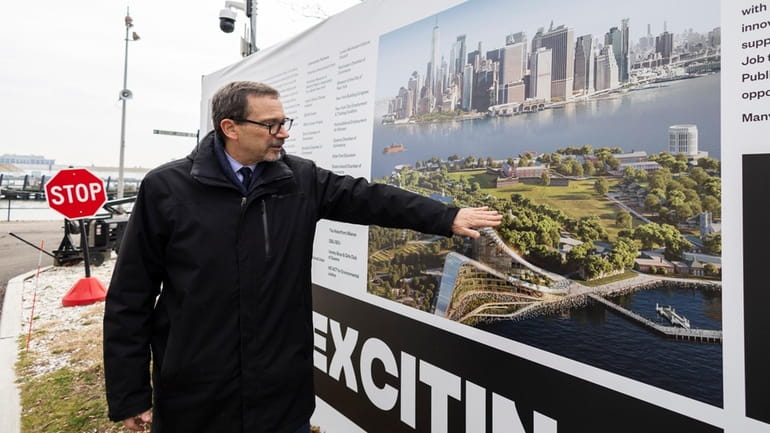New York Climate Exchange: What to know about Stony Brook U.-anchored project

Stephen Hammer, CEO of the New York Climate Exchange, shows a rendering of the site on Governor's Island that will be home to the Climate Exchange anchored by Stony Brook University. Credit: Corey Sipkin
When Stephen Hammer, newly appointed head of the New York Climate Exchange, looks over the site on Governors Island, he can envision its transformation that will take place over the next few years.
It’s a mix of preserving the heritage of the island off southern Manhattan that used to house a military base and building a self-sustaining living laboratory that draws researchers from all over the world and is anchored by Stony Brook University.
Last year, New York City Mayor Eric Adams announced that Stony Brook University had won the two-year competitive process to anchor the climate hub. He said the plan would generate 7,000 permanent green jobs plus 2,200 construction jobs, give a $1 billion boost to the local economy, and reach thousands of K-12, college and graduate students with educational programming.
Hammer, who served as the top climate adviser at the World Bank and was appointed founding CEO of the Climate Exchange, recently led a tour of the site where banners proclaim “The Future Is Here.” It’s scheduled to open in 2028.
WHAT TO KNOW
- The New York Climate Exchange on Governors Island will serve as an international center for developing solutions to the global climate crisis and act as a hub for green jobs training.
- The campus will include a combination of renovated historic buildings and new construction. The project is anchored by Stony Brook University.
- Construction is scheduled to start in 2026. Final engineering and design work is underway. Staff is currently being hired.
What is the goal of the Climate Exchange?
The site will serve as an international center for developing solutions to the global climate crisis and act as a hub for green jobs training.
“The campus is intended to be a living lab to expose the public to climate issues and opportunities,” he said. “So both the building and landscaping will involve the latest sustainability concepts, passersby will be able to observe some of the research underway on the island, and they’ll get to participate in workshops aimed at enhancing their own knowledge on climate issues.”
The campus would generate all energy used there, and include new classrooms, laboratories, research labs, public exhibition space, student and faculty housing and auditorium spaces.
What will it look like?
Governors Island was a military post and later a major command headquarters for the Army from 1794 until 1966, when it was transferred to the Coast Guard, which left in 1996. The state opened the island to the public before handing control to New York City in 2010.
The campus will include a combination of renovated historic buildings and new construction. It will be accessible by a new hybrid-electric ferry going into service this summer.
Faculty will be housed in former military officer housing while students will be housed in former military barracks refashioned as dormitory space. The campus is close to facilities supporting green tech incubation and a nonprofit organization aiming to introduce oysters to New York Harbor.
A former military base theater will be restored to host conferences featuring scientists and policy experts. The campus will include research labs, food service establishments and 4.5 acres of new open space.
“So this is going to be a campus in its entirety. You will have a variety of activities from learning to technology incubation to research to public spaces that the city and people from around the world can come and enjoy,” Hammer said.
How is Stony Brook University involved and what will it mean for Long Island?
Several years ago, the city issued a call for proposals, and a consortium led by Stony Brook University responded with a concept explaining how it would use the site with a strong focus on climate.
“They began to reach out and talk to different groups about who could come together and who was interested in coming together to build something new and completely different,” Hammer said.
Each of the different partners will have access to the research facilities and students will have access to the dormitory spaces.
Hammer said climate issues of interest to Long Islanders such as coastal erosion and flooding will likely be part of the research.
How will it be funded, when will it open and what’s next?
Construction is scheduled to start in 2026. Final engineering and design work is underway. Staff is being hired.
In the meantime, the staff is exploring ways to allow the exchange to host various climate-related meetings, panel discussions and training sessions on the island by late summer.
An event is scheduled for April 12 that will look into the impact the Canadian wildfires had on New York City.
“We are in the process of trying to launch some initial pilot activities,” said Kevin Reed, a professor in Stony Brook’s School of Marine and Atmospheric Sciences who is also interim director of academic, research and commercialization programs for the Climate Exchange.
He said Stony Brook students will be able to eventually take courses and attend workshops on the island.
The city previously allocated $150 million in capital funding to the project. That pairs with a $100 million Simons Foundation donation and $50 million from the philanthropy of former New York City Mayor Michael Bloomberg.
The consortium — led by Stony Brook and including IBM, Georgia Tech, Duke, the University of Washington, New York University, Oxford University, Rochester Institute of Technology, Pace University and CUNY, among others — must raise the rest of the $700 million development costs and ongoing funding needs.
Part of the funds will go to support art installations reinforcing the campus’ climate theme.
Is there opposition to the project?
Not everyone applauds the development on Governors Island, which attracts nearly a million visitors annually to its open space, waterfront promenades, cultural events and historic buildings.
A group called the Metro Area Governors Island Coalition has challenged what it sees as plans that ruin the island’s “uniquely welcoming openness and expansive parklands quality.”
A lawsuit by opponents of what they consider to be excessive height, density and development on Governors Island was dismissed last year. It was recently appealed and dismissed again, according to court documents.
Some opponents at a recent news conference in Manhattan said they were not against a climate center on the island but expressed concern about what development would follow.

